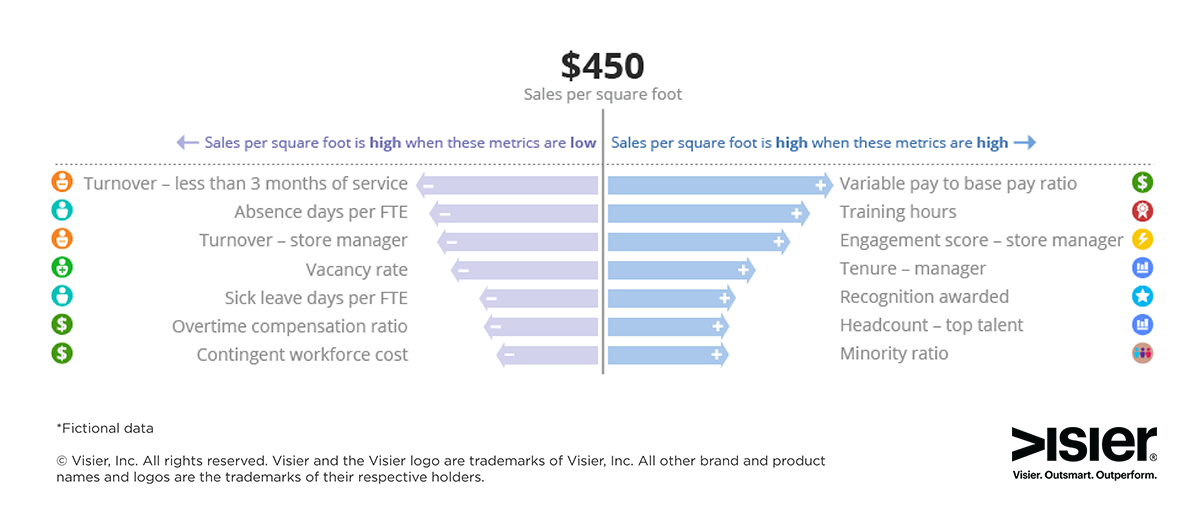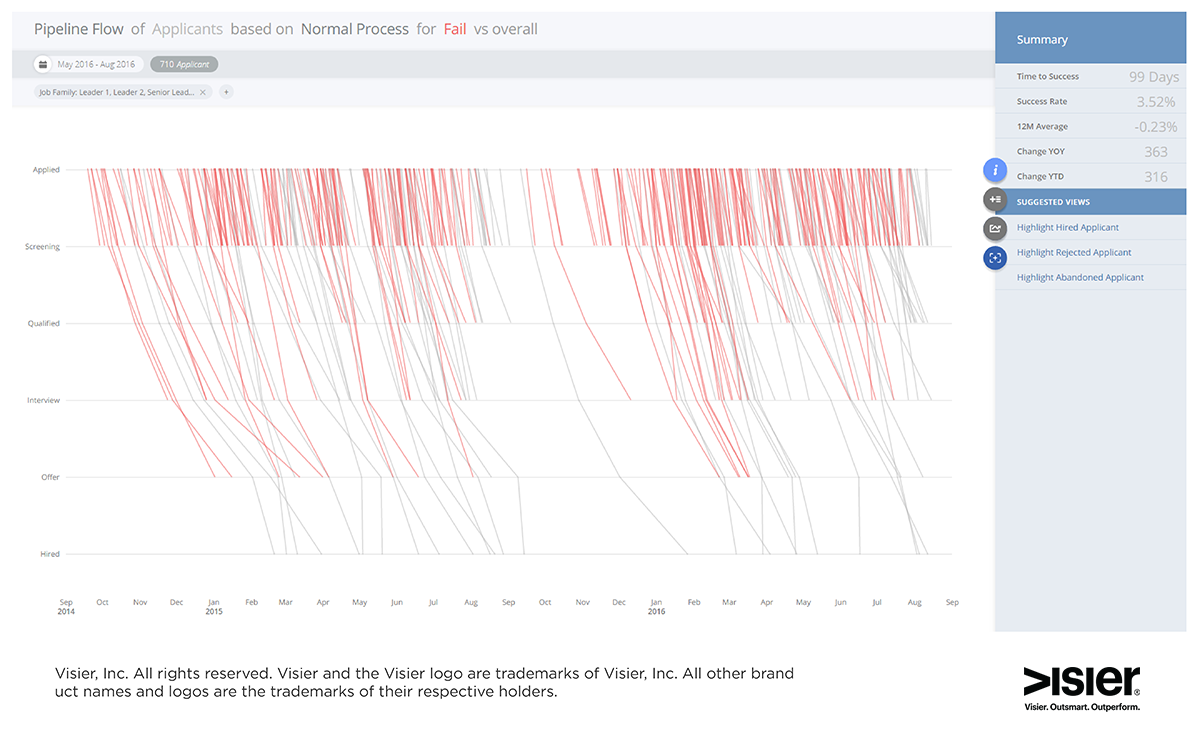As seen on Visier.
This “think piece” is designed to challenge your thinking on talent metrics/analytics
Everyone in HR should be aware that among the global business concerns of CEO’s, Human Capital is literally the top issue. And, unfortunately, Human Capital has been their #1 concern for four years in a row (Source: The Conference Board).
In my view, a significant part of the CEO dissatisfaction comes from the weak metrics and analytics that HR has been providing them. As a result, I call most Human Capital metrics “so what metrics” because the primary response that they get is a “so what” or “why should I care” reaction. And because of that mundane reaction, when CEO’s read our metrics they certainly don’t take any action.
Instead, we should be providing them with what I call WOW or OW analytics. These are not only guaranteed to get their immediate attention (either positive or negative) but they are powerful enough to also drive them to demand immediate action. Let’s start with an illustrative example:
You report your standard turnover metric – that your salesforce turnover rate is 20%. But then you add a comparison number, like the industry average is 9%, so they begin to see the scope of the problem. And when you convert the metric to its dollar impact – such as turnover reduced our sales revenue by $2.3 million – you immediately get their attention. And when you report that much of the turnover was preventable (for example, 78% of the turnover was preventable by using stay interviews) you have turned a “so what metric” into an “OW metric” (ouch we need to take action!).
If you can think like a CEO while reading this article, I believe you will quickly see what we are doing wrong and how to dramatically improve your HR and Talent Acquisition metrics.
First Understand A CEO’s Strategic Reporting Preferences
The first step in getting a CEO’s attention is to understand that they have strategic preferences covering the things that you report to them. Those CEO preferences mean that they prefer that you report one favored factor over another. After reporting only WOW’s and OW’s, there are seven additional areas where our metrics reports often do not match their strategic preferences. They include:
1. Dollars…over numbers and words
CEO’s think of everything in terms of dollars because dollars are literally “the language of business.” In addition, the consistent converting of problems and opportunities into dollars allows executives to quickly make comparisons between the problems faced by many different business functions.
2. Revenue… over cost-cutting
Actions that increase revenue have the highest value. Simply because you can’t increase revenue without satisfying customers and producing a product that sells more or that you can charge a premium for. Cost-cutting has a lower value because it is simply assumed that professionals always operate with the lowest cost structure. Cost-cutting also only has a short-term impact. While hiring actions that increase revenue have a much longer term impact because top-performing hires will continue to have a multiyear impact on your firm’s results.
Recommended Read: 7 Ways to Improve your Hiring In 2017
3. Innovation… plus productivity
The most productive workers produce up to nine times more than the average worker, so increasing productivity is always important. However, the most valuable firms like Apple, Google and Amazon are serial innovation firms because of their ability to continually innovate. Because innovators may have a 25 to 100 times greater business impact, CEO’s prefer you to focus on recruiting, retaining and developing innovators first.
4. Strategic business impacts… over functional impacts
CEO’s are focused on corporate strategic goals, so they are most concerned about functional actions that directly impact those goals. So it does little good to report on functional successes (like improve recruiting and retention) unless you first show how those functional successes directly impacted strategic goals. Reporting tactical metrics that distract CEO’s from the strategic goals is a catastrophic error.

5. Predictive analytics… over historical metrics
All traditional HR metrics are historical because they tell you what happened last year. CEO’s are focused on the future. So they want to hear about what will happen “next year” when there is time to do something about it. So when you have a choice, report predictive analytics. Unfortunately, one survey revealed that the least effective thing that we do in HR is predictive analytics.
6. Results and outputs… over process efficiency
CEO’s are focused on results, so they only want to see metrics that report results and outputs. Process efficiency metrics are important internally but don’t waste a CEO’s time with them.
7. Prompts covering the needed actions… over silence
Because CEO’s are action oriented. So once you get their attention they expect you also to provide a list of the required actions. Without guidance covering the optimal solution, a CEO may hesitate or even worse, take the wrong action. A standalone metric won’t drive “the right action” unless you provide a list of the most powerful solutions along with it.
Ow! Metrics In Talent Acquisition That CEO’s Would Want To Know About
After you fully understand the CEO’s data and analytic preferences, the next step is to focus on both positive and negative areas where recruiting significantly impacts business results. I recommend that you start with data and analytics covering the cost of recruiting failures. After studying hundreds of firms, I have found that many Talent Acquisition functions simply don’t adequately track many of the areas that have a high negative impact on recruiting and business results. Some of those OW! metric areas include:
- New hire failure rates – CEO’s would be alarmed to know that the failure rate within 18 months for most new hires from hourly employees to executives is close to 50%. And unfortunately, only 19% of our hires are considered “an unequivocal success.” Obviously, these results would fail a Six Sigma test. So it’s time for Talent Acquisition to do what every other business function does, and that is to clearly define a hiring failure and then calculate our overall failure rate.
- The cost of a bad hire – With such a high hiring failure rate, it makes sense to also calculate the costs of a bad hire. First, we need to realize that the mistakes, failures and disruptions and lost opportunities resulting from a toxic hire can be up to 10 times their annual salary (Source:Resoomay).
Recommended Read: How Workforce Analytics Helps Prevent Another Bad Hire
We must also realize that weak hires can take up almost one full day per week of a manager’s time. Additionally, one slacker or jerk in a group can bring down performance by 30% to 40% and a single toxic employee makes teammates 54% more likely to quit. Replacing a weak manager equals the impact of adding 1 teammate to a team. The obvious first step is to work with the CFO’s office to put a dollar amount on each of these negative impacts at your firm.
- Application drop operates – Everyone would be alarmed if 9 out of 10 potential customers dropped out before completing your initial application process. However, Indeed found that “The typical Fortune 500 company loses 9 out of 10 qualified applicants to these unwieldy processes.” So if your application process isn’t 100% mobile accessible or if it takes more than five minutes to complete, you now know why you’re suffering from a shortage of applicants. Unfortunately, most firms don’t track their application drop-off rate.
- Not reporting the business impacts of diversity hiring – There are now numerous studies that show a lack of diversity hiring in customer and product impact jobs can negatively impact sales, productivity, innovation, and even the turnover of non-diverse employees. Reporting diversity “numbers” is no longer sufficient, we must also calculate the value added by diversity in dollars.
- The impacts of unconscious bias on hiring – Talent Acquisition leaders should also be identifying the negative impacts that unconscious bias has on diversity hiring. The results may lead to “the masking” of names on resumes. Because two different studies found that having a “Black” or Middle Eastern name by itself may result in 3 to 5 times fewer interview offers.
- Reporting the cost per hire but not the impact of new hires – The most commonly reported Talent Acquisition metric is the cost per hire. But instead of reporting this minor one-time expense, Talent Acquisition leaders should be reporting the total long-term dollar impact of your top hires in key positions because their impact is in the millions. It’s also important to realize that saving money when you are recruiting salespeople on sources or recruiters might have the “unintended consequences” of hiring salespeople that sell 10% to 25% less.
- Headcount isn’t in dollars – The primary goal of most headcount measures is to determine if our labor costs are growing. However, we report it as “the number of heads,” when it really needs to be converted into the total dollars of salary that we spend each year.

Final Thoughts
In my view, Talent Management and Talent Acquisition analytics and data have come a long way in the last handful of years. However, when compared to the analytics of other business functions, they still have a long way to go. And the biggest problem that has still to be overcome is the fact that TA hasn’t yet learned the importance of converting our recruiting results into their dollar impacts.
Next, talent leaders seem to want to bombard executives with a large volume of metrics. And to make matters worse, many reported metrics are strictly tactical rather than strategic.
So, instead, I recommend that you only focus on and report metrics that demonstrate a strategic business impact. And if you’re not sure what your executives consider to be strategic, work directly with individual executives to sort out the strategic metrics from the no impact “so what metrics.”
After adding these “OW!” or “ouch metrics,” Talent Acquisition should shift their focus towards providing metrics that result in positive business impacts. Those Talent Acquisition metrics can be found in my follow-up article: “Impress Your CEO With These Strategic Business Impact Recruiting Metrics.”
Image: rawpixel
 Dr John Sullivan Talent Management Thought Leadership
Dr John Sullivan Talent Management Thought Leadership

